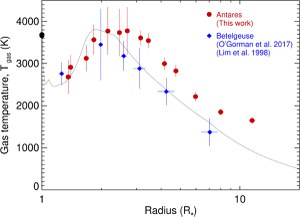The Lukewarm Chromosphere of Antares
 The authors present spatially resolved ALMA and Jansky VLA continuum observations of the early-M red supergiant Antares to search for the presence of a chromosphere at radio wavelengths. The free-free emission of the Antares atmosphere is resolved at 11 unique wavelengths between 0.7 mm (ALMA band 8) and 10 cm (VLA S band). The projected angular diameter is found to continually increase with increasing wavelength, from a low of 50.7 milli-arcseconds (mas) at 0.7 mm, up to a diameter of 431 mas at 10 cm, which corresponds to 1.35 and 11.6 times the photospheric angular diameter, respectively.
The authors present spatially resolved ALMA and Jansky VLA continuum observations of the early-M red supergiant Antares to search for the presence of a chromosphere at radio wavelengths. The free-free emission of the Antares atmosphere is resolved at 11 unique wavelengths between 0.7 mm (ALMA band 8) and 10 cm (VLA S band). The projected angular diameter is found to continually increase with increasing wavelength, from a low of 50.7 milli-arcseconds (mas) at 0.7 mm, up to a diameter of 431 mas at 10 cm, which corresponds to 1.35 and 11.6 times the photospheric angular diameter, respectively.
All four ALMA measurements show that the shape of the atmosphere is elongated, with a flattening of 15% at a similar position angle. The disk-averaged gas temperature of the atmosphere initially rises from a value of 2700 K at 1.35 R⋆ (i.e., 0.35 R⋆ above the photosphere) to a peak value of 3800 K at ∼2.5 R⋆, after which it then more gradually decreases to 1650 K at 11.6 R⋆. The rise in gas temperature between 1.35 R⋆ and ∼2.5 R⋆ is evidence for a chromospheric temperature rise above the photosphere of a red supergiant. The authors detect a clear change in the spectral index across the sampled wavelength range, with the flux density Sν∝ ν1.42 between 0.7 mm and 1.4 cm, which they associate with chromosphere-dominated emission, while the flux density Sν ∝ ν0.8 between 4.3 cm and 10 cm, which they associate with wind-dominated emission. The authors show that Antares’s outer atmosphere is transparent at their observed wavelengths, and the lukewarm chromosphere that was detected is thus real and not just an average of the cool molecular shell and hot ultraviolet emitting gas. We then perform nonlocal thermal equilibrium modeling of the far-ultraviolet radiation field of another early-M red supergiant, Betelgeuse, and find that an additional hot (i.e., > 7000 K) chromospheric photoionization component with a much smaller filling factor must also exist throughout the chromospheres of these stars.
Figure caption: Comparison of the temperature structure of the extended atmospheres of the early-M supergiants Antares and Betelgeuse. The filled red circles are the measurements summarized in this work for Antares, and the filled blue diamonds are the measurements for Betelgeuse from previous work. The gas temperature error bars include the uncertainty in absolute flux density scale. The overlapping filled black circles at R⋆ = 1 represent the photospheric effective temperatures of Antares and Betelgeuse. The solid black line is the temperature profile of the semiempirical model for the extended atmosphere of Betelgeuse discussed in this paper.
Publication: E. O’Gorman (Dublin Institute for Advanced Studies) et al., ALMA and VLA Reveal the Lukewarm Chromospheres of the Nearby Red Supergiant Antares and Betelgeuse, Astronomy & Astrophysics, 638, A65 (2019).
NRAO Press Release: Supergiant Atmosphere of Antares Revealed by Radio Telescopes




Connect with NRAO